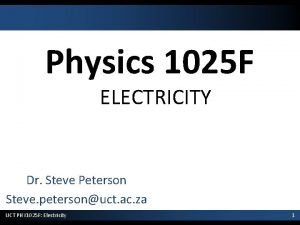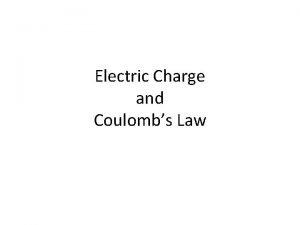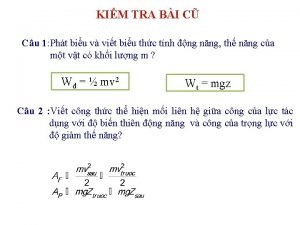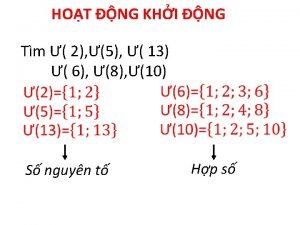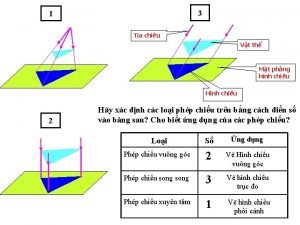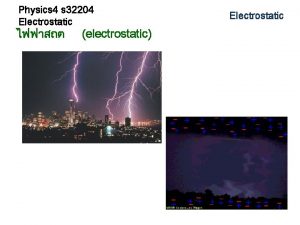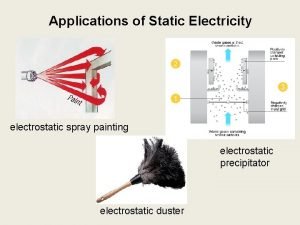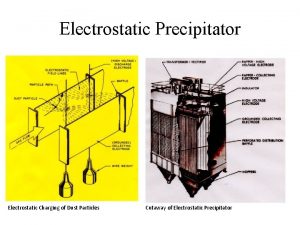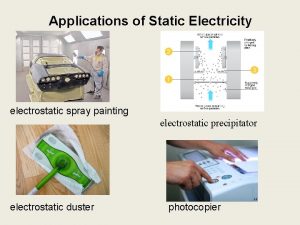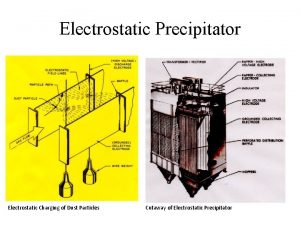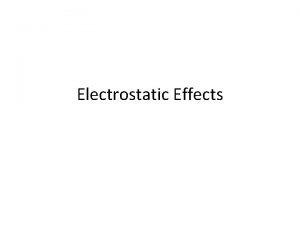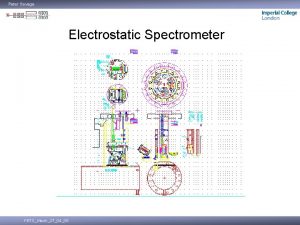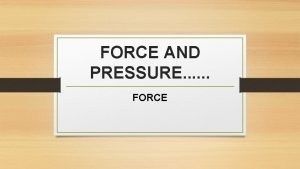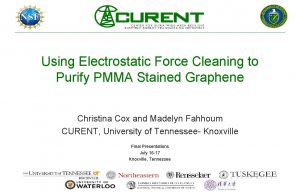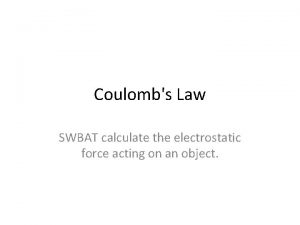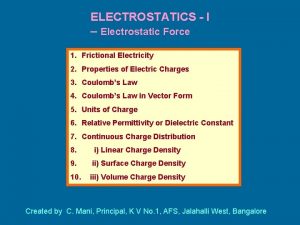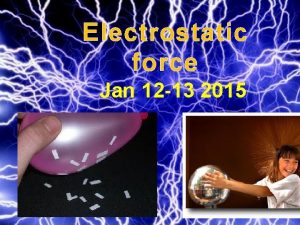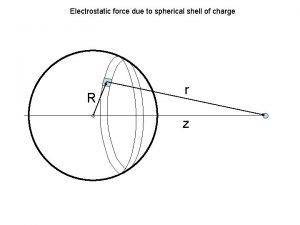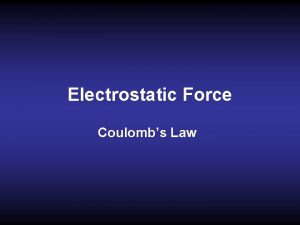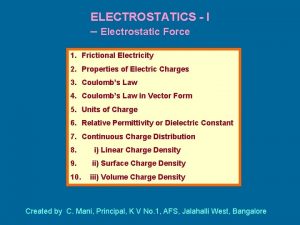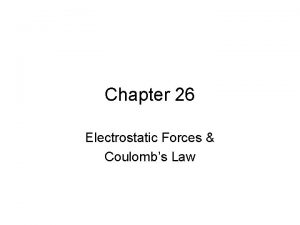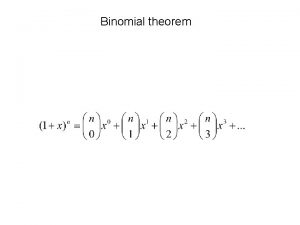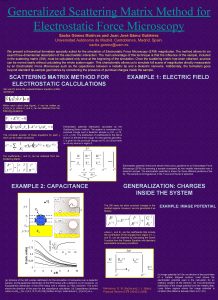Electrostatic Force Electrostatic Force Electrostatic Force is the






























- Slides: 30

Electrostatic Force

Electrostatic Force • Electrostatic Force is the attraction or repulsion of objects due to their electric charge • A force is a push or pull acting on an object, measured in newtons (N) • If force is unbalanced, it can cause an object to move. • An electrostatic force is the force that exists between static charges. • It can either pull the static charges together (force of attraction) or push static charges apart (force of repulsion).

Electric Force Depends on: 1. Type of charge on the objects (positive, negative, neutral – push, pull, nothing) 2. Amount of charge on the objects 3. Distance between objects

Electric Force If objects are really far away, would they have the same attraction (force drawing them together) as two objects very close together?

Coulomb’s Law • The strength of the electric force increases with increasing electric charges and decreases with distance.

Van de Graaff Generator • Generates very high electric charge. • Used to investigate electrostatic force.

How does it work? • Motor turns rubber belt • Charge comb picks up negative charges from belt • Belt transfers charge to dome

Van de Graaf Generator, Activity p 286 Safety 1. Always stand on insulated surface 2. Discharge dome often with grounding rod 3. Wait for dome to be grounded and belt to be turned off before taking hands off Answer questions p 287 #1, 2, 7, 9

Van de Graaff and Coulombs’s Law • As the charge builds up on the dome, the electric force between the dome and the discharge ball increases. • DIRECT RELATIONSHIP: as the electric force increase as the charge increases. • However, as distance decreases, the electric force increases (INVERSE RELATIONSHIP)

Van de Graaff 1. Explain the behaviours of the bubbles by describing the movement of the charges 2. Describe how the electric force varies with the distance between the ball and the dome 3. Describe how the electric force varies with the size of the charge on the dome

Uses and Examples of Static Electricity • Notes

Homework • Read pages 285 -286 • Answer CYU p 287 #1, 2, 3, 9

ETRAS

Check Your Understanding • During a physics lab, a plastic strip was rubbed with cotton and became positively charged. The correct explanation for why the plastic strip becomes positively charged is that. . . a. the plastic strip acquired extra protons from the cotton. b. the plastic strip acquired extra protons during the charging process. c. protons were created as the result of the charging process. d. the plastic strip lost electrons to the cotton during the charging process.

CYU #2 • Saran Wrap has a larger electron affinity (attraction) than Nylon. If Nylon is rubbed against Saran Wrap, which would end up with the excess negative charge? ______ Explain.

CYU #3 A physics teacher rubs a glass object and a felt cloth together and the glass becomes positively charged. Which of the following statements are true? Choose all that apply. a. The glass gained protons during the rubbing process. b. The felt became charged negatively during this rubbing process. c. Charge is created during the rubbing process; it is grabbed by the more charge-hungry object. d. If the glass acquired a charge of +5 units, then the felt acquires a charge of -5 units. e. This event violates the law of conservation of charge. f. Electrons are transferred from glass to felt; protons are transferred from felt to glass. g. Once charged in this manner, the glass object and the felt cloth should attract each other. h. In general, glass materials must have a greater affinity for electrons than felt materials.

CYU #4 Which statement best explains why a rubber rod becomes negatively charged when rubbed with fur? a. The rubber that the rod is made of is a better insulator than fur. b. The fur is a better insulator than the rubber. c. Molecules in the rubber rod have a stronger attraction for electrons than the molecules in the fur. d. Molecules in the fur have a stronger attraction for electrons than the molecules in the rubber rod.

What’s happening here?

Example • You transfer some of your charge to the metal door knob.

Why are neutral objects attracted to charged objects? • because the neutral objects are temporarily charged by induction. • A negatively charged balloon sticks to a neutral wall because the balloon’s negative charges repel the wall’s negative charges. • A positive charge is induced on the surface of the wall • the negative balloon is attracted to the positive wall surface.

Check Your Understanding Two neutral conducting pop cans are touching each other. A positively charged balloon is brought near one of the cans as shown below. The cans are separated while the balloon is nearby, as shown. After the balloon is removed the cans are brought back together. When touching again, can X is ____. a. positively charged b. negatively charged c. neutral d. impossible to tell

CYU #2 Two neutral conducting pop cans are touching each other. A positively charged glass rod is brought near Can X as shown below. Which of the following occur as the glass rod approaches Can X? List all that apply. a. Electrons jump from the glass rod to can X. b. Electrons jump from the glass rod to can Y. c. Electrons jump from can X to the glass rod. d. Electrons jump from can Y to the glass rod. e. Protons jump from the glass rod to can X. f. Protons jump from can X to the glass rod. g. . nonsense! None of these occur.

CYU #3 TRUE or FALSE? Two neutral conducting pop cans are touching each other. A negatively charged balloon is brought near Can X as shown below. As the balloon approaches Can X, there is a movement of electrons between the balloon and can X (in one direction or the other). a. TRUE b. FALSE

CYU #4 A positively charged balloon is brought near a neutral conducting sphere as shown below. While the balloon is near, the sphere is touched (grounded). At this point, there is a movement of electrons. Electrons move ____. a. into the sphere from the ground (hand) b. out of the sphere into the ground (hand) c. into the sphere from the balloon d. out of the sphere into the balloon e. from the ground through the sphere to the balloon f. from the balloon through the sphere to the ground g. . . nonsense! Electrons do not move at all.

CYU #5 Suppose that a negatively charged balloon is used to charge an electroscope by induction. Draw the orientation of the needle and indicate the location and type of any excess charge in steps ii. - v. Explain in terms of electron movement what is happening in each step.

Answer #5

CYU #6 • A negatively charged balloon is brought near a neutral conducting sphere as shown below. As it approaches, charge within the sphere will distribute itself in a very specific manner. Which one of the diagrams below properly depicts the distribution of charge in the sphere?

CYU #7 A positively charged piece of Styrofoam is placed on the table. A neutral aluminum pie plate is brought near as shown below. While held above the Styrofoam, the aluminum plate is touched (grounded). At this point, there is a movement of electrons. Electrons move ____. a. out of the aluminum plate into the ground (hand) b. into the aluminum plate from the ground (hand) c. into the aluminum plate from the Styrofoam d. out of the aluminum plate into the Styrofoam e. from the ground through the aluminum plate to the Styrofoam f. from the Styrofoam through the aluminum plate to the ground g. . . nonsense! Electrons do not move at all.

CYU #2 Which of the diagrams below best represents the charge distribution on a metal sphere when a positively charged plastic tube is placed nearby?

CYU #5 • Charged rubber rods are placed near a neutral conducting sphere, causing a redistribution of charge on the spheres. • Which of the diagrams below depict the proper distribution of charge on the spheres? • List all that apply.
 Calculate the magnitude of the electrostatic force
Calculate the magnitude of the electrostatic force What is electric charge
What is electric charge Electrostatic force
Electrostatic force Electrostatic force
Electrostatic force Electrostatic force
Electrostatic force Electrostatic force mean
Electrostatic force mean Quá trình desamine hóa có thể tạo ra
Quá trình desamine hóa có thể tạo ra Công thức tiính động năng
Công thức tiính động năng Thế nào là mạng điện lắp đặt kiểu nổi
Thế nào là mạng điện lắp đặt kiểu nổi Khi nào hổ mẹ dạy hổ con săn mồi
Khi nào hổ mẹ dạy hổ con săn mồi Dot
Dot Nguyên nhân của sự mỏi cơ sinh 8
Nguyên nhân của sự mỏi cơ sinh 8 Bổ thể
Bổ thể Vẽ hình chiếu đứng bằng cạnh của vật thể
Vẽ hình chiếu đứng bằng cạnh của vật thể độ dài liên kết
độ dài liên kết Thiếu nhi thế giới liên hoan
Thiếu nhi thế giới liên hoan Hát lên người ơi
Hát lên người ơi điện thế nghỉ
điện thế nghỉ Một số thể thơ truyền thống
Một số thể thơ truyền thống Trời xanh đây là của chúng ta thể thơ
Trời xanh đây là của chúng ta thể thơ Các số nguyên tố
Các số nguyên tố đặc điểm cơ thể của người tối cổ
đặc điểm cơ thể của người tối cổ Tỉ lệ cơ thể trẻ em
Tỉ lệ cơ thể trẻ em Phối cảnh
Phối cảnh Các châu lục và đại dương trên thế giới
Các châu lục và đại dương trên thế giới ưu thế lai là gì
ưu thế lai là gì Hệ hô hấp
Hệ hô hấp Các môn thể thao bắt đầu bằng tiếng bóng
Các môn thể thao bắt đầu bằng tiếng bóng Tư thế ngồi viết
Tư thế ngồi viết Hình ảnh bộ gõ cơ thể búng tay
Hình ảnh bộ gõ cơ thể búng tay Cái miệng nó xinh thế
Cái miệng nó xinh thế
